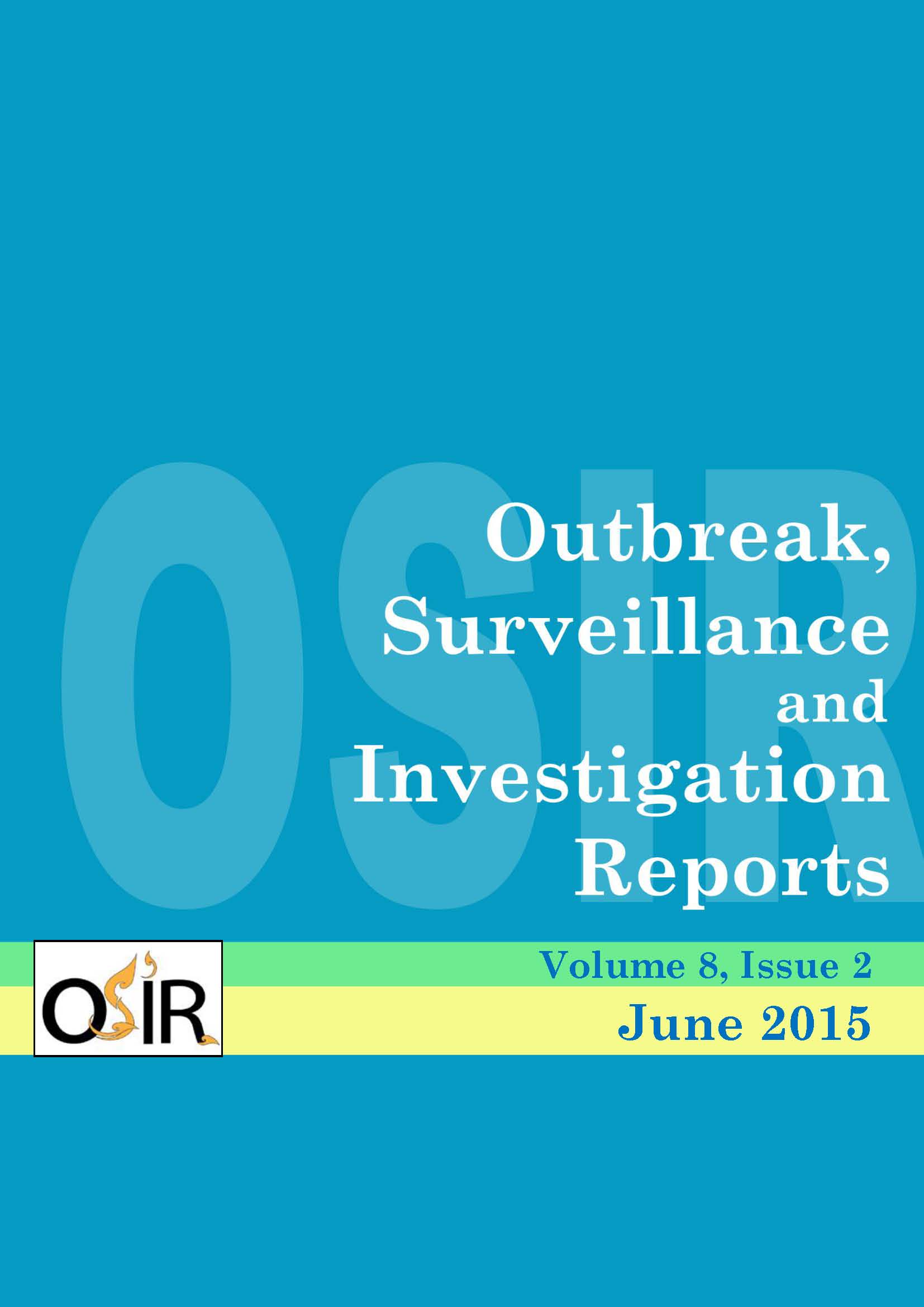An Investigation of Human Brucellosis and Goat Farm Network Analysis in Ratchaburi Province, 2013
DOI:
https://doi.org/10.59096/osir.v8i2.263277Keywords:
outbreak, investigation, brucellosis, Ratchaburi Province, goat farm networkAbstract
In April 2013, a person was confirmed to have Brucella melitensis in Chombueng District; and Ratchaburi Provincial Health Office notified about this patient to Bureau of Epidemiology. As the patient was a goatkeeper in a farm that had animal movement with other goat farms, active human case finding was conducted. History of goat movement among the related goat farms was explored to identify key persons for disease transmission in the network. Serum samples from 53 goatkeepers in 28 goat farms and two livestock officials who investigated the farm with confirmed case were tested for brucellosis. Only one goatkeeper was identified as a probable case, with attack rate of 1.8%. Goat serum specimens from 12 out of total 34 goat farms were tested positive for Brucella. In egocentric network, 44 nodes were included in the network analysis, including 34 goat farms, four slaughterhouses and six merchant’s goat shelters. Visualization from network analysis was useful to identify goat farm networks at risk of disease spreading. Key person in the network with the highest degree centrality (26) and betweenness centrality (2455.462) was identified as a merchant’s goat shelter with a goat tested positive for brucellosis. Hence, knowledge on brucellosis prevention and control should be disseminated among goatkeepers and merchants in that network. The information should also be used for strengthening communication between goat farmers and local livestock officials.
References
Corbel MJ. Brucellosis in humans and animals. Geneva: World Health Organization; 2006.
Elzer PH, Hagius SD, Davis DS, DelVecchio VG, Enright FM. Characterization of the caprine model for ruminant brucellosis. Vet Microbiol. 2002 Dec 20;90(1-4):425-31.
Ekgatat M. Brucellosis and diagnosis in Thailand. Bangkok: National Institute of Animal Health; 2009.
Wongphruksasoong V, Santayakorn S, Sitthi W, Chuxnum T, Doung-ngern P, Pipatjaturon N, et al. Investigation of brucellosis case and death in Chondaen District, Phetchabun Province, Thailand, December 2009. Weekly Epidemiological Surveillance Report. 2010; 41(34): 539-44.
Laosiritaworn Y, Hinjoy S, Chuxnum T, Vagus A, Choomkasien P. Re-emerging Human Brucellosis, Thailand 2003. Bulletin of the Department of Medical Services. 2007;32(4):415-23.
Benton DC, Fernández Fernández MP. Social network analysis: a tool for the identification of next generation trainers. Collegian. 2014 Dec;21(4):311-8.
Penghirun K. Risk factors of foot and mouth disease occurrence on social network of smallholder dairy farmers, Nongpho Dairy Co-Operative Ltd. (Under the Royal Patronage) [thesis]. Nakhon Phathom: Kasetsart; 2013.
Valente TW. Social network and health: models, methods, and applications. New York: Oxford University Press; 2010.
Borgatti SP, Everett MG, Freeman LC. Ucinet for Windows: software for social network analysis. Harvard, MA: Analytic Technologies. 2002 [cited 2015 Feb 2]. <https://sites.google.com/site/ucinetsoftware/home>
Suddee W. Prevalence and fisk factors associated with Brucella spp. infection in meat goats and quantitative release assessment of Brucella spp. into Chainat Province by live meat goats importation [thesis]. Nakhon Phathom: Kasetsart; 2011.
Mikolon AB, Gardner IA, Hernandez De Anda J, Hietala SK. Risk factors for brucellosis seropositivity of goat herds in the Mexicali Valley of Baja California, Mexico. Prev Vet Med. 1998 Dec 1;37(1-4):185-95.
Nöremark M, Håkansson N, Lewerin SS, Lindberg A, Jonsson A. Network analysis of cattle and pig movements in Sweden: measures relevant for disease control and risk based surveillance. Prev Vet Med. 2011 May 1;99(2-4):78-90. Epub 2011 Feb 1.
Brucellosis in human and animals: WHO guidance. Geneva: World Health Organization; 2005.
Downloads
Published
How to Cite
Issue
Section
License
Copyright (c) 2023 Outbreak, Surveillance, Investigation & Response (OSIR) Journal

This work is licensed under a Creative Commons Attribution-NonCommercial-NoDerivatives 4.0 International License.









